Photographs: www.esamskriti.com Sanjeev Nayyar
Sanjeev Nayyar recently visited the Hampi festival and came back with these lovely pictures and charming stories to tell!
For many years, I was yearning to visit Hampi, the erstwhile capital of the great Vijayanagara Empire. But things as they say, happen only when they ought to.
Hampi covers an area of 26 sq km and is on the southern bank of the river Tungabhadra in Karnataka. You can reach Hampi by either taking a night train to Hospet from Bangalore (335 km) or an overnight bus from Mumbai to Hospet from where Hampi is only 15 km. Luxury coaches also ply between Goa and Hampi (323 km) fairly regularly.
The history of Hampi goes back to the time of the Ramayana. There are many monuments and places that are associated with the Epic.
Hampi and the area around it were ruled by many dynasties including the Kadambas, Chalukyas, Rashtrakutas and the Hoysalas.
Around 1326 Muhammad-bin-Tughluk conquered the area but within ten year the Sangama brothers Harihara and Bukka regained the land and founded Vijayanagara or 'City of Victory'.
It is also called 'Vidyanagara' in memory of the sage Vidyaranya of Sringeri-math, who is credited with founding the city and the empire.
Key sites to see in Hampi are Matanga Parvata (an ideal spot to watch sunrise), Achuta Raya temple, Vithhala temple and Lakshmi-Narasimha statue (which is a must-see), Virupaksha temple, Sasivekalu Ganapathi and Krishna temple.
In the royal enclosure area see Lotus Mahal, Sister's Rock, Bhima's Gate, Queen's Bath, Hazara-Rama temple and Mahanavami-Dibba (platform).
Do not forget to take a boat ride in round basket-boats or coracles in river Tungabhadra and watch the sunset from Hemakuta Hill.
Karnataka Tourism organises the Hampi Festival every year from January 27 to January 29. I was fortunate to be there at the time.
The following pages will give you an insight into the glorious city and its wonderful festival.
...
Sanjeev Nayyar is founder www.esamskriti.com and a travel photo journalist.
Virupaksha Temple
Image: Virupaksha Temple, HampiThe temple of Virupaksha or Pampapati enshrines the tutelary deity of the Vijayanagara rulers. It is most sacred monument of Hampi.
Pampa is the ancient name of Tungabhadra on whose bank Hampi is located. The word 'Hampi' is generally held to be a later Kannada form of 'Pampa'.
The temple was made in phases from the 7th century to Krishnadevaraya's rule (1509-1528) and has a sanctum, vestibule, pillared hall, a large sabha mantapa (meeting hall), pillared cloisters and many subsidiary shrines.
The highlights of the Ranga mantapa include the paintings on its ceilings dating back to the Vijayanagara period. The Ranga mantapa has tall elegant entrance towers to the North, South and the East that are known for their stucco sculptures.
The temple overlooks the Hampi bazaar, with the remains of many ancient mantapas, which was the most important thoroughfare in the ancient city of Vijayanagara. It is a few minutes away from the Tungabhadra River.
What you see is the east market entrance to the temple. The gopura (52 metre high) is a well-proportioned nine-storeyed structure with a two-tiered stone base and a brick superstructure.
Proluganti Tippa, a commander of Devaraya II (1422-46 AD) and Krishnadeva Raya repaired it in 1510.
The royal procession
Image: The royal processionThe Hampi Festival started on January 27. What you see alongside is the royal procession that happened on the previous evening as elephants, dancers, musicians and artists walked towards the Virupaksha Temple. Artists enacted scenes from the Ramayana.
Hampi has many guesthouses, which provide decent accommodation. Average room rent varies from Rs 600 to Rs 1200 for a night. Stay close to the market or across the Tungabhadra River. The place is very peaceful, close to rice fields and mostly frequented by foreigners. Probably cheaper too!The entire city and monuments are lit up
Image: The entire city and monuments are lit up during the three-day festival.During the three festival days the entire city and its monuments are lit up, which is no mean task. The Karnataka tourism department however did a superb job. It was almost as if the festival of lights, Diwali, was being celebrated.
When you walk up the road from the Hampi market to Hemakuta Hill you see a fully lit mantapa with boulders in the background.
Seeing monuments at night, lit up, is a different and once-in-a-lifetime experience. If you are in Hampi during the festival, make it a point to walk through the evening -- from the Vithhala temple to the Royal Citadel -- it is some walk but worth every step.
The Hampi market has a number of restaurants which serve good Indian and western food. There are many Internet cafes and travel agencies. You can also book your tickets online. Visit Mango Tree restaurant on the banks of the Tungabhadra. The food is good, caters to every palate and the ambience is divine.Sasivekalu Ganesha
Image: Sasivekalu GaneshaThis is situated on the Hemakuta hill. This monolithic Ganesha is four armed and is referred to as Sasivekalu (mustard seed) Ganesha. It stands 2.4 metres high and is in an open, plain and pillared pavilion.
The statue seated in half lotus posture (ardha padmasana) bears a tusk, goad, noose and bowl of sweets in its four arms.
An inscription nearby indicates that this Vinayaka Mandapa was built in 1506 by a trader belonging to Chandragiri (near Tirupati in Andhra Pradesh) in memory of Narasimha II (1491-1505) of the Saluva dynasty.Lakshmi-Narasimha statue
Image: Lakshmi-Narasimha statue, HampiThis monolith of Lakshmi-Narasimha stands at a height of 6.7 metres. Narasimha is the fourth incarnation of Lord Vishnu. Along with the stone chariot at Vithhala Temple it is the most popular symbol of Hampi and one of the finest examples of Vijayanagara sculpture.
Narasimha is seated on the giant coils of Adishesha, the sacred guardian snake of Vishnu, its seven hoods act as a canopy, arched by a Kirtimukha in front.
The roof the chamber is missing since it has been damaged. As you can see the four arms of the statue have been broken and the seated figure of his consort, Lakshmi, on his left lap, is missing.
The face too has been damaged which has misled people to people that it was an angered Narasimha. The statue was consecrated by the priest Krishnabhatta at the behest of Krishnadevaraya in 1528.
This is about 10-minute away from the Hampi market and is on the way to the Royal Enclosure. Next to this statue is a three-metres monolith Shiva Linga that is carved out of one rock.Sister Rocks
Image: Sister Rocks, HampiThese are two sister boulders that form a huge natural arch. Such arches are popularly known inthe Bellary region as Akka Thangi Gundu or sister boulders.
All over Hampi I saw boulders in the most unimaginable positions and wondered how they continued to be in absolute equilibrium.
The rocks are en route from Narasimha statue, after the underground Shiva temple and towards the Royal Citadel ruins.
The best way to see Hampi is on foot and bicycle. The walk from the market to Vitthala temple is about 30 minutes and takes you through the ruins.
You can hire a cycle for Rs 40 per day or a moped for Rs 250 per day (petrol charges extra). Keep three days to see Hampi or to do so in a relaxed manner keep four.
Mahanavami Dibba
Image: Mahanavami Dibba or the Dussera platform in Hampi is a royal platformThe royal throne forms part of the Royal Enclosure, the nucleus of the capital city of Vijayanagara that occupies an area of 59,000 sq m and housed as many as 43 buildings.
This massive east-facing platform rises to a height of 12m and is built in three diminishing tiers. The first and the second tiers measure 40 and 24 sq m respectively.
The platform was the hub of religious ceremonies like Durga puja, Navaratri, Dipavali that were publicly celebrated by the Vijayanagara kings.
The Mahanavami platform is also called the house of victory. The platform is decorated with panels depicting elephants, dancers, musicians, medallions and miniature shrines carved in relief.
Throughout my Karnataka trip, I found people to be friendly, helpful and honest. There were no language issues as most people spoke and understood Hindi.
For a good English- and Hindi-speaking guide contact Prakash 944-8795-114. Stay at Padma, Santosh or Ranjana guesthouses that are close to the bus stand.The Stone Chariot
Image: The Stone Chariot , one of the most beautiful pieces of architecture, is actually a temple carved out of stone in the shape of a chariot.The Stone Chariot is part of the Vitthala Temple complex and is a reproduction of a processional wooden chariot and is perhaps the most stunning achievement, typical of the Vijayanagara period. It has an image of Garuda, the vehicle of Vishnu.
The Chariot was built around 1510-1513 to commemorate the victory of Krishnadevaraya over Orissa king. The king was an accomplished scholar and poet.
His Telegu poem, Amuktamalyada, enunciates the characteristics of an ideal monarch and the principles of political administration adhered by him.
All the intricate details found in a wooden ratha are simulated in the Stone Chariot. It is carved out of a single rock to resemble temple chariots or rathas in which temple idols were traditionally taken out in procession.
Observe the picture carefully and imagine the skills required to make it.Marriage Hall, Vitthala Temple
Image: The Kalyana Mandapa or marriage hall almost surpasses the Maha Mandapa in beauty.The Kalyana Mandapa or marriage hall almost surpasses the Maha Mandapa in beauty. It has an open pillared mandapa that you see which is symmetrically planned with deeply recessed sides and has the usual arrangement of composite pillars and a highly ornate ceiling.
Note the exquisitely carved pillars. It has 50 pillars, is 500 feet in length and 310 feet in width.
The huge platform that you see in the picture is where the marriage took place. The inscription records the construction of 1554.
During January, nights and early mornings tend to be cold but days are very sunny. Carry your sunglasses and a cap if you must and a short-sleeve sweater.Water channels
Image: The Royal Enclosure area has efficient arrangements for supplying water, storing it and drainage system.The Royal Enclosure area has efficient arrangements for supplying water, storing it and drainage system.
Water was brought from an external source through a main aqueduct running in the middle of the enclosure, which is what you see in the picture.
On the right of picture towards the end there is a water outlet that goes into a stepped tank.
The main aqueduct branched into a network of sub-channels to feed 23 small and big tanks within the enclosure. Importantly, there were wells at the junction between the main aqueduct and branches that were sources of water in the times of emergency.
Hampi has been rightly described as the world's largest open-air museum and I consider myself blessed to have gone there.
For more photos, check http://www.esamskriti.com/photo-detail/Hampi-Festival.aspx.
For more details on Hampi, check www.hampionline.com.
Historical narratives borrowed from Hampi booklet published by the Archaeological Survey of India and sign boards outside each monument.
Want to share your travel story with us and others around the world? Simply write an email (with the subject line: 'My most memorable vacation') and send it to getahead@rediff.co.in. Also send us pictures of the place you're writing about. We will publish the best ones right here on rediff.com!

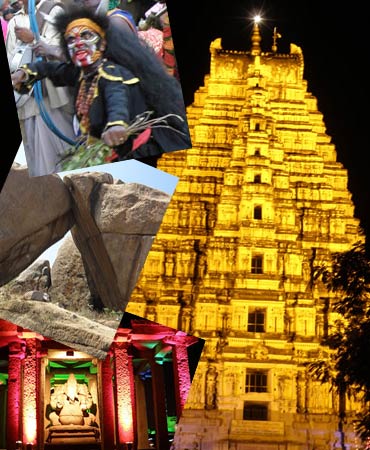
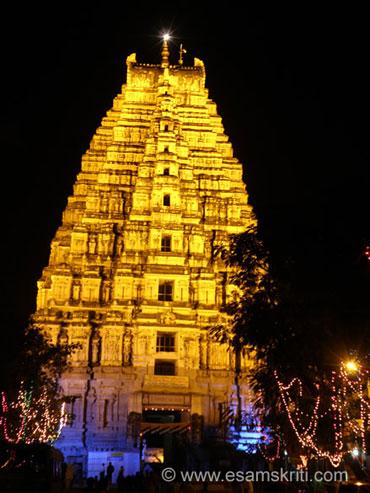
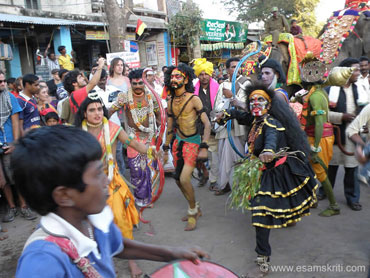
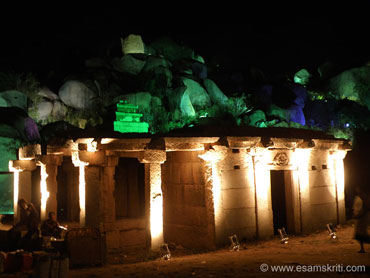

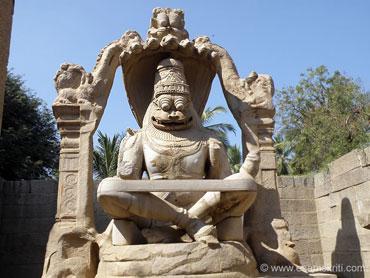
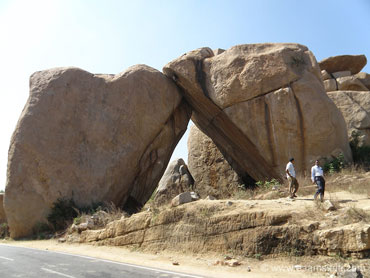

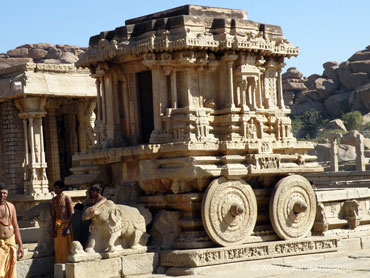
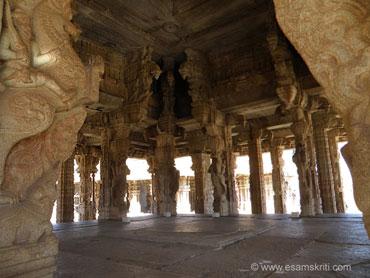

Comment
article